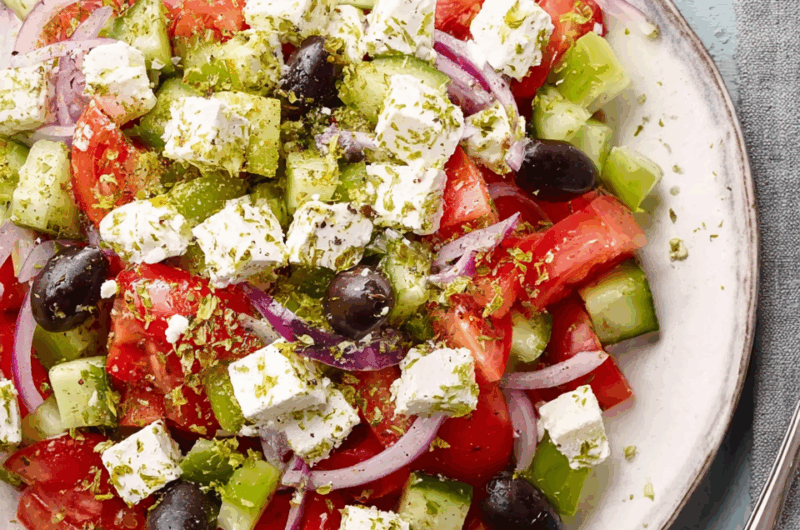This Greek Cucumber & Tomato Salad is a burst of Mediterranean freshness in every bite. Crisp cucumber, juicy tomatoes, and sharp red onion mingle with tangy feta and briny olives, all tied together with a zesty lemon-olive oil dressing. The flavors are clean yet bold, making it a perfect light lunch or side dish for grilled meats and seafood.
It’s as simple as it is satisfying – no cooking required. A quick chill in the fridge lets the dressing soak into the veggies for maximum flavor. Serve it at picnics, barbecues, or weeknight dinners when you want something wholesome and refreshing without spending hours in the kitchen.
Full Recipe:
-
2 Roma tomatoes, chopped
-
1/2 large cucumber, thinly sliced
-
1/2 small red onion, thinly sliced
-
1 1/2 tablespoons olive oil
-
2 teaspoons lemon juice
-
1/2 teaspoon salt
-
1/4 teaspoon black pepper
-
Pinch of dried oregano
-
1/2 cup crumbled feta cheese
-
6 kalamata olives, quartered
-
2 cups chopped romaine lettuce
Directions:
-
In a small bowl, whisk together olive oil, lemon juice, salt, black pepper, and oregano.
-
Place tomatoes, cucumber, and onion in a large mixing bowl.
-
Pour the dressing over the vegetables and toss to coat evenly.
-
Cover and refrigerate for 30 minutes to allow flavors to blend.
-
Just before serving, add chopped romaine lettuce and gently toss.
-
Sprinkle with feta cheese and olives. Serve chilled.
Prep Time: 15 minutes | Cooking Time: 0 minutes | Total Time: 45 minutes (including chilling)
Kcal: ~150 kcal | Servings: 4 side servings
The Essence of a Greek Cucumber & Tomato Salad with Feta
The Greek Cucumber & Tomato Salad with Feta is more than just a side dish – it’s a vibrant celebration of Mediterranean simplicity, flavor, and freshness. With its origins deeply rooted in Greek cuisine, this salad, often referred to as “Horiatiki” in its traditional form, embraces the idea that wholesome, uncomplicated ingredients can create an unforgettable culinary experience. Each bite captures the balance of crisp textures, juicy vegetables, briny depth from olives, and the tangy creaminess of feta cheese, all tied together by the refreshing lift of lemon and olive oil. Its appeal lies in its ability to feel light yet satisfying, making it suitable for warm-weather dining or as a year-round companion to various meals.
Cultural and Culinary Background
Greek salads hold an iconic place in Mediterranean culinary tradition. Historically, this style of salad was born from local farmers’ markets and gardens, using produce that was fresh, abundant, and seasonally available. The ingredients were not heavily altered or dressed; instead, the emphasis was on highlighting the natural flavors of vegetables and regional cheeses. Feta, a protected designation of origin (PDO) cheese, is made primarily from sheep’s milk or a blend of sheep and goat’s milk, providing a distinct tangy-salty contrast that balances the sweetness of ripe tomatoes and the cool crunch of cucumbers. Olives, another essential component, have been part of Greek diets for thousands of years and contribute both flavor and healthy fats to the dish. This combination represents a true embodiment of the Mediterranean diet—simple, nutrient-rich, and deeply connected to the land and sea.
Nutritional Benefits and Wellness Appeal
One of the reasons this salad has remained popular for decades is its exceptional nutritional profile. It’s naturally rich in vitamins, minerals, and antioxidants. The cucumbers provide hydration and vitamins K and C, tomatoes contribute lycopene—a powerful antioxidant linked to heart health—while onions offer compounds known to support immune function. Feta cheese adds a source of calcium and protein, and olives supply heart-healthy monounsaturated fats. The dressing, made with olive oil and lemon juice, further boosts the salad’s nutritional value by providing vitamin C, phytonutrients, and healthy fats that help absorb fat-soluble vitamins from the vegetables. Together, these components make the Greek Cucumber & Tomato Salad a well-balanced option that supports cardiovascular health, aids digestion, and promotes overall vitality.
Flavor Profile and Texture Experience
The magic of this salad lies in its perfect interplay of flavors and textures. Tomatoes bring sweetness and juiciness, while cucumbers deliver a refreshing crunch. Red onions contribute a mild pungency that cuts through the richness of the feta. The olives add a briny bite that enhances the savory notes of the cheese. The dressing—bright with lemon and rounded with smooth olive oil—ties everything together, coating each bite in a light, fragrant sheen. What makes this combination so satisfying is its balance: no single ingredient overwhelms the others, and every forkful offers a little of everything, creating harmony in each mouthful.
Serving Suggestions and Pairings
This salad’s versatility makes it a perfect partner for a wide range of dishes. It shines as a side to grilled meats like lamb kebabs, chicken souvlaki, or fresh seafood such as grilled sardines and salmon. It can also serve as a light main course when paired with warm pita bread, hummus, or grilled halloumi cheese. In a more contemporary twist, some enjoy this salad over a bed of quinoa or farro for a heartier grain-based bowl. Its ability to complement both rustic Greek fare and modern fusion plates means it can easily transition from a casual backyard lunch to a more formal dinner setting.
Tips for the Best Results
While this salad is incredibly straightforward, a few techniques can elevate its flavor. Selecting ripe, seasonal tomatoes is key—they should be fragrant and slightly soft to the touch without being mushy. Cucumbers should be firm, with a vibrant green skin, and preferably seedless for the best texture. Red onions can be mellowed in flavor by soaking slices in cold water for a few minutes before adding them to the salad. For the feta, opt for block feta stored in brine rather than pre-crumbled versions; it retains more moisture and flavor. Lastly, allowing the salad to rest for 20–30 minutes before serving helps the flavors meld together without losing the crispness of the vegetables.
Why It’s Perfect for All Seasons
Although it is often associated with summer dining, the Greek Cucumber & Tomato Salad can be enjoyed year-round. In the warmer months, it provides a cooling, hydrating side to grilled and roasted dishes. In winter, it offers a bright burst of freshness alongside heartier foods like roasted lamb, moussaka, or baked fish. Its adaptability comes from the fact that most of the ingredients are widely available, and the salad itself requires no cooking—making it a go-to option when you want something quick, healthy, and visually appealing.
Adaptations and Creative Twists
While the traditional recipe is perfect in its own right, it can also be adapted to suit different tastes and dietary needs. For a vegan version, the feta can be replaced with plant-based cheese or omitted entirely. Adding roasted chickpeas or white beans can increase the protein content, turning the salad into a complete meal. Fresh herbs like parsley, dill, or mint can add a fragrant twist, while a sprinkle of toasted seeds or nuts provides extra crunch. Some cooks like to add a touch of red wine vinegar to the dressing for a sharper tang, or swap romaine lettuce for arugula to give the salad a peppery edge.
A Dish That Brings People Together
Part of the charm of a Greek Cucumber & Tomato Salad lies in its communal appeal. It’s a dish that invites sharing—presented in a large bowl at the center of the table, encouraging everyone to serve themselves. In Greek culture, meals are a time for connection, conversation, and enjoyment, and this salad embodies that spirit. It’s colorful and inviting, and its refreshing nature makes it universally appealing to guests, whether they are seasoned food lovers or casual diners.
Conclusion
The Greek Cucumber & Tomato Salad with Feta is more than just a simple combination of vegetables and dressing—it’s a culinary tradition that carries the essence of the Mediterranean in every bite. Rooted in a culture that values fresh, local produce and balanced nutrition, this salad demonstrates how a few high-quality ingredients can create something far greater than the sum of their parts. It’s versatile enough to pair with a variety of dishes, nourishing enough to stand on its own, and adaptable for any season or dietary preference. Whether enjoyed on a sunlit terrace in Greece or at a family table halfway around the world, this salad continues to win hearts with its simplicity, beauty, and unforgettable taste.








